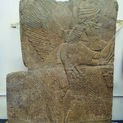
The arts of the ancient world have loomed largely in the Museum’s collection since its founding. The first major collection to enter the Museum included numerous Egyptian, Greek, Roman, and Etruscan vases. Today, the collection of ancient art numbers more than five thousand objects. The early civilizations of Mesopotamia, Iran, Asia Minor, and the Levant are documented by a wealth of diverse artifacts, and the long history of ancient Egypt is illustrated by outstanding examples of stone and pottery vessels, carved stone reliefs, bronze statuettes, wall paintings, amulets, and mummies. The collection of Greek art includes major works of Attic black-figure and red-figure vase painting, Archaic bronze statuettes, Hellenistic jewelry and terracotta figurines, pottery from Cyprus, Corinth, and Rhodes, and marble funerary and votive reliefs.
The heritage of ancient Italy is particularly well represented, beginning with a distinguished collection of Etruscan vases, sculptures, and metalwork and culminating in the arts of Rome and its empire. The Roman collection encompasses marble and bronze portraits, sculptures of gods, satyrs, and nymphs, sarcophagi and funerary monuments, glass vessels and carved bone reliefs, silver and gold coins, sealstones of agate and chalcedony, statuettes in bronze, amber, ivory, and clay, and a spectacular silver-gilt wine cup. Princeton’s distinguished record of archaeological research in Roman Syria is illustrated by unusual basalt sculptures from the Hauran region, funerary reliefs from the desert city of Palmyra, and a renowned collection of colorful mosaic pavements from the great metropolis of Antioch-on-the-Orontes.
The arts of Byzantium and the Islamic world receive equal attention, with painted icons, silver and gold jewelry, and delicate ivories from the Byzantine capital of Constantinople that share a gallery with painted pottery, intricately patterned metalwork, and glazed tiles from Syria, Egypt, Iran, and other centers of Muslim civilization.
In addition to the works on view, an ancient study gallery with hundreds of additional objects is open for the convenience of students and visitors. The collections of Greek and Roman sculpture are published in comprehensive scholarly catalogues, and many other works have been published in the Museum’s scholarly journal, the Record.



